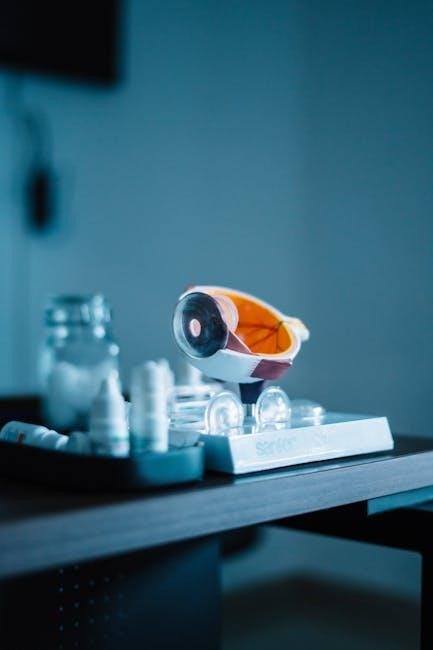Grant’s Atlas of Anatomy, a cornerstone since 1943, offers realistic dissection illustrations, detailed surface anatomy photos, and clinical relevance, making it a widely respected resource in anatomy education.
Historical Significance of Grant’s Atlas
Grant’s Atlas of Anatomy, first published in 1943, has become a foundational resource in anatomy education, renowned for its detailed illustrations and clinical relevance. Its establishment by John Charles Boileau Grant set new standards for anatomical education, providing students with accurate and pedagogical content. Over the decades, the atlas has evolved, incorporating modern advancements while maintaining its core commitment to excellence. Its historical significance lies in its ability to bridge traditional dissection methods with contemporary educational needs, making it a timeless tool for medical professionals and students worldwide. The latest edition continues this legacy, ensuring its relevance in modern anatomy education.
Overview of the Latest Edition
The latest edition of Grant’s Atlas of Anatomy continues its tradition of excellence, offering a comprehensive and visually detailed resource for anatomy education. It features enhanced dissection illustrations, updated surface anatomy photographs, and expanded clinical correlations. The new edition incorporates modern imaging techniques and recent anatomical discoveries, ensuring relevance for contemporary medical training. Designed for clarity and precision, it serves as an essential tool for students, educators, and professionals; This edition reflects a commitment to advancing anatomy education while maintaining the atlas’s historical legacy as a trusted reference in the field.

Key Features of the Latest Edition
The latest edition boasts realistic dissection illustrations, detailed surface anatomy photos, and clinical relevance with updated muscle tables, enhancing both learning and practical application for anatomy students and professionals.
Realistic Dissection Illustrations
The latest edition of Grant’s Atlas of Anatomy features exceptionally detailed and realistic dissection illustrations, providing unparalleled clarity for anatomy students and professionals. These illustrations are meticulously crafted to depict the human body’s complex structures with precision, making them indispensable for both educational and clinical use. The full-color plates are organized to follow a logical dissection sequence, allowing learners to visualize the relationships between anatomical components. This level of detail enhances comprehension of intricate dissection layers and facilitates a deeper understanding of human anatomy. The illustrations are further complemented by surface anatomy photos and clinical correlations, ensuring a comprehensive learning experience.
Detailed Surface Anatomy Photos
Grant’s Atlas of Anatomy’s latest edition includes high-quality surface anatomy photos that bridge the gap between external landmarks and internal structures. These images, often paired with corresponding dissection plates, provide a clear visual guide for identifying key anatomical features. The photos are meticulously captured to reveal subtle details, aiding in the accurate localization of muscles, nerves, and vessels. This integration of surface anatomy with deeper dissections enhances the understanding of spatial relationships, making it an invaluable resource for both students and professionals in clinical and educational settings. The clarity and precision of these photos ensure practical relevance for anatomy education and practice.
Clinical Relevance and Muscle Tables
Grant’s Atlas of Anatomy’s latest edition emphasizes clinical relevance through detailed muscle tables and anatomical correlations. These tables provide essential information on muscle origins, insertions, innervations, and actions, making them a valuable resource for both students and professionals. The integration of clinical notes highlights the practical applications of anatomical knowledge in surgical procedures, diagnostic imaging, and patient care. This edition also includes updated data on anatomical variations and their clinical significance, ensuring readers can apply the content directly to real-world medical scenarios. Such enhancements make the atlas a comprehensive tool for bridging anatomy education and clinical practice effectively.
Revisions and Updates in the New Edition
The latest edition of Grant’s Atlas of Anatomy features significant revisions to enhance clarity and educational value. New dissection images have been added, showcasing intricate anatomical details with improved resolution. Clinical correlations have been expanded, providing learners with practical insights into how anatomy applies to patient care. Muscle tables now include updated information on functional anatomy, making them more relevant for students and professionals. Additionally, the atlas incorporates feedback from prior editions, refining its content to better meet the needs of modern anatomy education. These updates ensure the atlas remains a trusted resource for accurate and applied anatomical knowledge.

Educational Significance
Grant’s Atlas of Anatomy is a cornerstone in anatomy education, offering detailed visuals and clear explanations that enhance understanding for students and professionals alike.
Accuracy and Pedagogy in Anatomy Education
Grant’s Atlas of Anatomy excels in its precise and detailed anatomical representations, ensuring accuracy for both educational and clinical purposes. The latest edition incorporates a systematic approach, organizing content from surface to deep dissection, which enhances pedagogical effectiveness. Realistic illustrations and surface anatomy photos align with dissection experiences, bridging the gap between theoretical knowledge and practical application. The inclusion of clinical correlations and muscle tables further enriches its educational value, making it an indispensable resource for students and professionals seeking to master human anatomy with clarity and confidence.
Use in Dissection Labs
Grant’s Atlas of Anatomy is widely utilized in dissection labs due to its precise and visually detailed illustrations, which closely mirror actual dissection experiences. Students rely on its realistic depictions to identify anatomical structures, enhancing their understanding during practical sessions. The atlas’s regional organization aligns with typical dissection sequences, making it an invaluable companion for lab work. Its accuracy and clarity allow learners to correlate theoretical knowledge with hands-on observations, fostering proficiency in anatomy. The latest edition’s updates ensure relevance, making it a trusted resource for both novice and advanced dissectors seeking to refine their anatomical skills in dynamic laboratory environments.
Popularity Among Medical Students Worldwide
Grant’s Atlas of Anatomy remains a favorite among medical students globally due to its clear, detailed illustrations and organized content. Its popularity stems from its ability to simplify complex anatomical concepts, making it easier for learners to grasp and retain information. The atlas is widely recommended for its accuracy and relevance to modern anatomy education. Students appreciate its focus on clinical correlations, which aids in connecting theoretical knowledge to practical applications. Its widespread use in medical schools and its availability in digital formats further enhance its accessibility and appeal to students worldwide, solidifying its reputation as an indispensable study resource.

Digital Availability and Formats
The latest edition of Grant’s Atlas of Anatomy is widely available in digital formats, including PDF, ensuring easy access for students and professionals worldwide. Online platforms offer convenient downloads, while integrations with medical education resources enhance its utility for learners.
PDF Version of the Atlas
The latest edition of Grant’s Atlas of Anatomy is available in a convenient PDF format, offering users a portable and easily accessible version of the atlas. This digital format is popular among students and professionals due to its ability to be viewed on multiple devices, including laptops, tablets, and smartphones. The PDF version retains the high-quality illustrations and detailed content of the physical book, ensuring an excellent learning experience. It can be purchased directly from official publishers or authorized online retailers, providing instant access to the material. The PDF is also fully searchable and includes bookmarks for easy navigation, making it a valuable resource for anatomy education and reference.
Accessibility on Online Platforms
Grant’s Atlas of Anatomy is widely available on various online platforms, ensuring easy access for students and professionals worldwide. The latest edition can be purchased or accessed through official publishers, eBook retailers, and academic databases. Many universities and medical institutions provide digital access to the atlas through their libraries, making it a readily available resource for anatomy education. The online version is compatible with multiple devices, allowing users to study anytime, anywhere. This accessibility has made Grant’s Atlas a preferred choice for modern learners who value convenience and flexibility in their educational materials.
Integration with Medical Education Resources
The latest edition of Grant’s Atlas of Anatomy is seamlessly integrated with modern medical education resources, enhancing its utility for students and educators. It is often bundled with supplementary materials, such as interactive anatomy software, video tutorials, and practice questions, to create a comprehensive learning package. Many institutions incorporate the atlas into their curriculum, pairing it with other educational tools like cadaveric dissection guides and clinical case studies. This integration ensures that students can connect anatomical knowledge with practical applications, making it an indispensable resource for both classroom and clinical training environments.

Contributors and Authors
Grant’s Atlas of Anatomy is authored by renowned anatomists Anne M.R. Agur and Arthur F. Dalley II, with contributions from expert anatomists and medical educators globally.
Anne M.R. Agur and Arthur F. Dalley II
Anne M.R. Agur and Arthur F. Dalley II are distinguished anatomists and educators, renowned for their expertise in human anatomy and medical education. As lead authors of Grant’s Atlas of Anatomy, they have significantly enhanced the latest edition with updated dissection illustrations, clinical correlations, and educational content. Their collaborative effort ensures the atlas remains a premier resource for anatomy students and professionals worldwide. Agur’s expertise in anatomical research and Dalley’s experience in medical education have contributed to the atlas’s clarity, accuracy, and relevance in modern anatomy training.
Expertise in Anatomy and Medical Education
Anne M.R. Agur and Arthur F. Dalley II bring unparalleled expertise in anatomy and medical education to Grant’s Atlas of Anatomy. Agur, a leading anatomist, has extensively researched functional anatomy, while Dalley, a seasoned educator, specializes in making complex concepts accessible. Their combined expertise ensures the atlas is both scientifically rigorous and pedagogically effective. Their work bridges anatomy and clinical practice, providing students and professionals with a comprehensive understanding of human structure and function. Their contributions have solidified the atlas as an indispensable tool in anatomy education and clinical training worldwide.

Organization of the Atlas
The atlas is meticulously organized, following a surface-to-deep dissection sequence, with a regional anatomy focus. It includes a comprehensive index and detailed references for easy navigation.

Surface-to-Deep Dissection Sequence
Grant’s Atlas employs a systematic surface-to-deep dissection approach, enabling learners to explore anatomy layer by layer. Each region begins with superficial structures, progressing to deeper tissues, mirroring real dissection. This sequence enhances understanding of spatial relationships and anatomical continuity, making complex dissections intuitive. The clarity of illustrations and logical progression ensure that users can follow anatomical details effortlessly, from skin to bones, muscles, nerves, and vessels. This method aligns with how anatomy is typically studied in labs, providing a practical and educational framework for both students and professionals. The sequence is designed to build a strong foundational knowledge of human anatomy systematically and effectively.
Regional Anatomy Focus
Grant’s Atlas emphasizes a regional anatomy approach, organizing content by body regions such as the head, neck, and limbs. Each section provides in-depth coverage of structures within a specific area, including muscles, nerves, and blood vessels. This focus allows learners to understand anatomy in a clinically relevant context, enhancing spatial awareness and the ability to correlate structure with function. The atlas integrates detailed dissections with clear illustrations, making it easier to visualize and study regional anatomy systematically. This approach aligns with dissection-based anatomy courses, offering a practical and focused learning experience for students and professionals alike.
Comprehensive Index and References
Grant’s Atlas features a detailed and comprehensive index, enabling quick access to specific anatomical structures and concepts. The index is meticulously organized, cross-referencing illustrations, tables, and clinical notes. This ensures seamless navigation for users seeking precise information. The atlas also includes an extensive reference section, citing authoritative sources and recent studies. These references support the accuracy of the content and provide further reading opportunities. The combination of a robust index and thorough references makes the atlas an indispensable resource for both academic and professional use, ensuring reliability and depth in anatomy education and practice.

Practical Applications
Grant’s Atlas is widely used in clinical settings, surgical training, and medical education. It serves as a valuable reference for surgeons, educators, and researchers, aiding in diagnosis and treatment planning while providing detailed anatomical insights essential for precise medical procedures.
Use in Clinical Settings
Grant’s Atlas is a trusted resource in clinical environments, aiding healthcare professionals in understanding complex anatomy. Its detailed illustrations and surface anatomy photos help in diagnosing and planning treatments. The atlas’s clinical relevance section bridges anatomy with practical patient care, making it invaluable for radiologists, surgeons, and physiotherapists. The regional focus ensures quick reference during fast-paced clinical scenarios, while updated content reflects modern medical practices. This makes it an indispensable tool for accurate decision-making and patient outcomes, ensuring anatomical precision in real-world applications.
Reference for Surgical Training
Grant’s Atlas serves as a vital reference for surgical training, offering precise anatomical details essential for preoperative planning. The atlas’s realistic dissection illustrations and surface anatomy photos aid surgeons in identifying landmarks and understanding spatial relationships. Its clinical relevance section enhances surgical decision-making by correlating anatomy with common procedures. Surgical residents and professionals rely on its updated content, which reflects modern surgical practices. The atlas’s regional anatomy focus aligns with surgical specializations, making it an indispensable resource for mastering operative techniques and improving surgical outcomes.
Application in Research and Academia
Grant’s Atlas is a cornerstone in research and academia, providing unparalleled anatomical accuracy for scientific studies. Its detailed illustrations and surface anatomy photos serve as a reference for researchers conducting anatomical analyses. Academic institutions worldwide use the atlas to enhance lectures and labs, ensuring students grasp complex anatomical concepts. The latest edition’s digital availability further facilitates its integration into curricula and research projects. By bridging detailed anatomy with clinical relevance, Grant’s Atlas supports advancements in medical research and education, making it an indispensable tool for scholars and investigators alike.

Comparisons with Previous Editions
The latest edition of Grant’s Atlas offers enhanced illustrations, updated clinical relevance, and improved pedagogical tools compared to earlier versions, making it more versatile for both students and professionals.
Improvements in Illustrations and Content
The latest edition of Grant’s Atlas features refined and updated illustrations, enhancing anatomical accuracy and detail. New digital imaging techniques provide clearer, high-resolution visuals, improving student understanding. Surface anatomy photos now include more diverse subject examples, reflecting real-world variations. Muscle tables have been expanded with additional information on attachments, innervations, and actions, aiding in comprehensive study. The content has been reorganized for better flow, with regional anatomy sections now more logically structured. These updates ensure the atlas remains a cutting-edge resource for anatomy education, blending tradition with modern advancements to meet the needs of today’s learners.
Enhanced Clinical Relevance
The latest edition of Grant’s Atlas emphasizes enhanced clinical relevance, making it indispensable for medical professionals and students. New case studies and clinical correlations bridge anatomy with real-world applications, aiding in diagnosis and treatment. Updated imaging, including MRI and CT scans, aligns with modern diagnostic tools. Expanded pathology content highlights anatomical changes in diseases, enriching understanding. Clinician-contributed insights ensure practical relevance, making the atlas a valuable resource for both education and professional practice. These enhancements underscore the atlas’s role in connecting anatomy to clinical medicine, benefiting learners and practitioners alike.
Modernization of Anatomy Education
The latest edition of Grant’s Atlas reflects a modernized approach to anatomy education, blending traditional dissection-based learning with contemporary digital tools. The atlas now incorporates interactive digital content, including 3D models and virtual dissections, to enhance student engagement. Updated terminology aligns with current anatomical nomenclature, ensuring relevance. The integration of evidence-based learning strategies improves retention and understanding. By adapting to technological advancements, Grant’s Atlas remains a leader in anatomy education, providing students with a comprehensive and immersive learning experience that aligns with 21st-century medical training demands.

Reviews and Feedback
Grant’s Atlas is widely praised for its clarity and detail, with students and professionals appreciating its updated content and digital accessibility. Some note a steeper learning curve for new features.
Student and Professional Reviews
Students and professionals widely acclaim the latest edition of Grant’s Atlas for its enhanced illustrations and clinical correlations. Many praise its detailed dissection guides and surface anatomy photos, which aid in exam preparation and surgical planning. The PDF version is particularly popular for its portability and ease of access. However, some users note that the sheer volume of information can be overwhelming for newcomers. Overall, it remains a top choice for anatomy education, balancing traditional dissection techniques with modern clinical relevance.
Criticisms and Areas for Improvement
While Grant’s Atlas is highly regarded, some users note its limitations. The PDF version’s large file size can hinder performance on older devices. Additionally, the lack of an interactive search feature in the PDF makes quick navigation challenging. A few critics mention that the text accompanying illustrations can be dense, potentially overwhelming for beginners. There is also room for improvement in the clinical correlation sections, as some find them less detailed than expected. Addressing these issues could further enhance the atlas’s usability and accessibility for students and professionals alike.
Future Prospects
Future editions may integrate AR for 3D visualization, offer personalized learning features, and expand coverage of rare anatomical variations, enhancing its role in modern education.
Technological Advancements in Anatomy Education
The latest edition of Grant’s Atlas of Anatomy is poised to embrace technological advancements, enhancing anatomy education through interactive 3D models and augmented reality (AR) integration. Digital versions, such as the PDF, may evolve into immersive platforms, allowing users to explore anatomy dynamically. AI-driven tools could offer personalized learning paths and real-time annotations. Virtual reality (VR) integration may enable students to practice dissections virtually, complementing traditional labs. These innovations aim to bridge the gap between theoretical knowledge and practical application, making anatomy education more accessible and engaging for future generations of medical professionals.
Possible Integration with AI and VR
The integration of AI and VR into Grant’s Atlas of Anatomy could revolutionize anatomy education. AI might enable adaptive learning, tailoring content to individual needs and enhancing retention. Virtual reality (VR) could provide immersive, 3D anatomical experiences, allowing users to explore structures interactively. This integration could complement traditional dissection labs, offering students a dynamic learning environment. Additionally, AI-driven tools might analyze user interactions, providing real-time feedback and fostering deeper understanding. Such advancements could make anatomy education more engaging and accessible, bridging gaps between theoretical knowledge and practical application for medical professionals and students alike.
Continuous Updates and Editions
Grant’s Atlas of Anatomy is renowned for its commitment to staying current with anatomical knowledge. Regular updates ensure the atlas reflects the latest advancements in medical science and teaching methodologies. Each new edition incorporates feedback from educators, students, and professionals, refining content for clarity and relevance. This iterative process maintains the atlas’s status as a trusted educational resource. By continuously evolving, it addresses the dynamic nature of anatomy education, ensuring users access accurate, up-to-date information. This dedication to improvement underscores its enduring value in medical training and practice.
Grant’s Atlas of Anatomy remains a cornerstone in medical education, offering precise, updated content that bridges anatomy and clinical practice. Its enduring relevance ensures continued influence on future generations of healthcare professionals and students alike.
Grant’s Atlas as a Cornerstone in Anatomy Education
Grant’s Atlas of Anatomy stands as a foundational resource in anatomy education, renowned for its precision and clarity. The latest edition integrates detailed dissections, surface anatomy, and clinical correlations, making it indispensable for students and professionals. Its systematic approach and realistic illustrations provide a comprehensive understanding of human anatomy. Widely adopted in medical curricula, the atlas bridges education and practice, ensuring its relevance for generations. Its enduring popularity underscores its role as a cornerstone in anatomy education, equipping learners with the essential knowledge needed for clinical excellence.
Impact on Modern Medical Training
Grant’s Atlas of Anatomy has profoundly influenced modern medical training by providing detailed, accurate, and clinically relevant content. Its realistic illustrations and surface anatomy photos enable students to better understand spatial relationships and anatomical structures. The latest edition’s integration of clinical correlations bridges the gap between theoretical knowledge and practical application. This resource is widely used in dissection labs and clinical settings, enhancing learners’ preparation for surgeries and patient care. Its accessibility in digital formats further supports modern learning preferences, solidifying its role as an essential tool in contemporary medical education and practice.